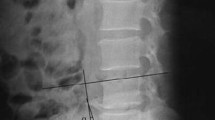Abstract
A total of 51 patients who underwent the second open discectomy by fenestration from January 1988 through December 1994, were followed for an average of 146.8 months. The long-term follow-up results were evaluated through direct examinations and questionnaires. At the final follow-up, according to the Macnab classification an excellent and good outcome was achieved in 70.6% of the cases, and 78.4% were satisfied with their results. The failure rate was 15.7% (8 patients). Excluding those 8 failed cases who needed another reoperation, the average improvement calculated by Japanese Orthopaedic Association (JOA) scores was 64.6%. Factors that were associated with a fair and bad outcome included smoking, isolated trauma or injury, fibrosis and the duration of the remaining or recurrent primary postoperative symptoms. We noted that psychosociological signs were probably negative predictors of lumbar disc surgery outcome. Because the revision operation is typically associated with a higher complexity, selection of suitable surgical candidates and determination of valid indications for operative treatment are very important.
Résumé
51 patients ont bénéficié d'une réintervention (deuxième intervention pour discectomie) entre janvier 1988 et décembre 1994 et ont été suivis en moyenne 146,8 mois. Les résultats à long terme ont été évalués après un questionnaire et un examen. Au suivi final 70,6% présentaient un excellent ou bon résultat suivant la classification de MacNab, 78,4% étant satisfaits de leur résultat. Le taux d'échec est de 15,7% (8 patients). Si l'on exclut ces huit patients qui ont nécessité une nouvelle réintervention, l'amélioration moyenne calculée selon le score de la JOA a été de 64,6%. Ces facteurs associés avec un mauvais résultat ou un résultat médiocre sont les patients fumeurs, les lésions post-traumatiques, les phénomènes de fibroses, un long délai entre la réintervention et l'intervention primaire. Les facteurs sociologiques sont souvent perçus comme des facteurs négatifs compte tenu du fait que la révision est souvent complexe, il est donc nécessaire de bien sélectionner les patients à réopérer avec des indications bien solides.
Similar content being viewed by others
References
Baba H, Chen Q, Kamitani K, Imura S, Tomita K (1995) Revision surgery for lumbar disc herniation. An analysis of 45 patients. Int Orthop 19:98–102
Cinotti G, Roysam GS, Eisenstein SM, Postacchini F (1998) Ipsilateral recurrent lumbar disc herniation. A prospective, controlled study. J Bone Joint Surg Br 80:825–832
Davis KG, Marras WS, Heaney CA, Waters TR, Gupta P (2002) The impact of mental processing and pacing on spine loading: 2002 Volvo Award in biomechanics. Spine 27:2645–2653
Deyo RA (2007) Back surgery — who needs it? N Engl J Med 356:2239–2243
Deyo RA, Weinstein JN (2001) Low back pain. N Engl J Med 344:363–370
Diwan AD, Parvartaneni H, Cammisa F (2003) Failed degenerative lumbar spine surgery. Orthop Clin North Am 34:309–324
Fandiño J, Botana C, Viladrich A, Gomez-Bueno J (1993) Reoperation after lumbar disc surgery: results in 130 cases. Acta Neurochir (Wien) 122:102–104
Fu TS, Lai PL, Tsai TT, Niu CC, Chen LH, Chen WJ (2005) Long-term results of disc excision for recurrent lumbar disc herniation with or without posterolateral fusion. Spine 30:2830–2834
Fritsch EW, Heisel J, Rupp S (1996) The failed back surgery syndrome: reasons, intraoperative findings, and long-term results: a report of 182 operative treatments. Spine 21:626–633
Goldberg MS, Scott SC, Mayo NE (2000) A review of the association between cigarette smoking and the development of nonspecific back pain and related outcomes. Spine 25:995–1014
Japanese Orthopedic Association (1986) Criteria on the evaluation of the treatment of low back pain. J Jpn Orthop Assoc 60:391–394
Jönsson B, Strömqvist B (1996) Clinical characteristics of recurrent sciatica after lumbar discectomy. Spine 21:500–505
Leboeuf-Yde C (1999) Smoking and low back pain. A systematic literature reviewof 41 journal articles reporting 47 epidemiologic studies. Spine 24:1463–1470
Loupasis GA, Stamos K, Katonis PG, Sapkas G, Korres DS, Hartofilakidis G (1999) Seven- to 20- year outcome of lumbar discectomy. Spine 24:2313–2317
Macnab I (1971) Negative disc exploration.An analysis of the causes of nerve-root involvement in sixty-eight patients. J Bone Joint Surg Am 53:891–903
Nygaard OP, Kloster R, Dullerud R, Jacobsen EA, Mellgren, SI (1997) No association between peridural scar and outcome after lumbar microdiscectomy. Acta Neurochir (Wien) 139:1095–1100
Oda H, Matsuzaki H, Tokuhashi, Y, Wakabayashi K, Uematsu Y, Iwahashi M (2004) Degeneration of intervertebral discs due to smoking: experimental assessment in a rat-smoking model. J Orthop Sci 9:135–141
Saruhashi Y, Mori K, Katsuura A, Takahashi S, Matsusue Y, Hukuda S (2004) Evaluation of standard nucleotomy for lumbar disc herniation using the Love method: results of follow-up studies after more than 10 years. Eur Spine J 13:626–630
Silvers HR, Lewis PJ, Asch HL, Clabeaux DE (1994) Lumbar diskectomy for recurrent disc herniation. J Spinal Disord 7:408–419
Suk KS, Lee HM, Moon SH, Kim NH (2001) Recurrent lumbar disc herniation: results of operative management. Spine 26:672–676
Vucetic N, Astrand P, Güntner P, Svensson O (1999) Diagnosis and prognosis in lumbar disc herniation. Clin Orthop 361:116–122
Weinstein JN, Tosteson TD, Lurie JD, Tosteson AN, Hanscom B, Skinner JS, Abdu WA, Hilibrand AS, Boden SD, Deyo RA (2006) Surgical vs nonoperative treatment for lumbar disk herniation: the Spine Patient Outcomes Research Trial (SPORT): a randomized trial. JAMA 296:2441–2450 2006
Yorimitsu E, Chiba K, Toyama Y, Hirabayashi K (2001) Long-term outcomes of standard discectomy for lumbar disc herniation: a follow-up study of more than 10 years. Spine 26:652–657
Author information
Authors and Affiliations
Corresponding author
Rights and permissions
About this article
Cite this article
Guo, J.J., Yang, H. & Tang, T. Long-term outcomes of the revision open lumbar discectomy by fenestration: A follow-up study of more than 10 years. International Orthopaedics (SICOT) 33, 1341–1345 (2009). https://doi.org/10.1007/s00264-008-0648-2
Received:
Revised:
Accepted:
Published:
Issue Date:
DOI: https://doi.org/10.1007/s00264-008-0648-2




